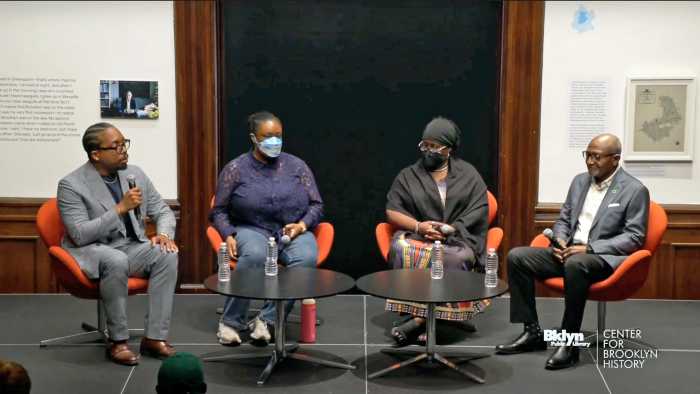Harlem activists speak out before a hearing on condoms and medications in prisons
On the morning on Friday, April 30, chanting “health care is a right, not just for the rich and white,” activists and former prison inmates brought their demands to the Harlem State Office Building on 125 Street before a hearing was held on prison health policy. The protest highlighted systematic neglect of prisoners’ basic rights to treatment for HIV, hepatitis C, and other STDs, as well as the state’s refusal to distribute condoms in prison.
“Twelve to 15% of the prison population is infected with HIV. One in four black men will be in prison at some point in their lives,” said Charles Cobb of the Harlem Directors Group. “Not providing access to HIV prevention is criminal.”
Robert Muriel, 43, who has been living with HIV for 18 years, spoke of horrendous conditions inside state facilities. Muriel’s access to HIV medication was interrupted several times during his incarceration at the Marcy Correctional Facility. Health experts warn that interrupted treatment produces life-long cross- resistance to medication, which can damage the immune system for years to come. “What was done to me is inhumane, barbaric, and inconsistent with contemporary standards of decency,” said Muriel. “I have a virus that is threatening my very existence, and the medications that were prescribed by a doctor were kept from me.”
The denial of basic health care to prisoners goes much further. Muriel carried pictures of his bruised face after an assault by another inmate that, according to him, could have been easily prevented. “I was kept in the same clothes for 13 days, and was not allowed to shower for five days,” he said. “With broken bones in my face, all they would give me is Tylenol.”
The rally was held to support legislation that would subject prisons to the standards of hospitals and would require the implementation of STD education and prevention programs. One bill would obligate the state’s department of health to review HIV and hepatitis C care, which is currently the sole province of the department of corrections.
The bills have passed in the state Assembly, but are bogged down in the Senate.
“This campaign has been going on for a year and a half,” said Graziela Tanaka, a leading organizer of the protest who works with the New York City AIDS Housing Network. “Protest and a legislative strategy are going together,” she said.
Mary Solomon, a former inmate who is HIV-positive, came to the protest in solidarity with her partner who is still incarcerated. “I’m here for all the inmates in state prison,” she said. “The doctors try their best, but the system’s got to do something.”
The burdens facing HIV-positive inmates are overwhelming. In prison, “women don’t want people to know they’re positive because of the stigma,” said Solomon. She remembers working with doctors who had no knowledge of the drugs she knew she needed. “At Riker’s Island, the doctors don’t even have any training in HIV treatment,” said Solomon.
Mark Milano, a member of ACT UP New York, just returned from a visit to Rikers, where he heard of many cases of prisoners who were unable to receive treatment. “We also need condoms in prison,” he added.
“One of the justifications they use for not distributing condoms is that there wouldn’t be any DNA evidence to investigate prison rape,” said Graziela Tanaka. Activists pointed out that only Los Angeles allows condom distribution. As numerous signs pointed out, this amounts to a death sentence for countless inmates.
“There was one man who was completely denied hepatitis C treatment,” said José Baez who was incarcerated at the Auburn Correctional Facility. “He was sentenced for 175 years to life, so he was told that since he was going to die there, he didn’t need treatment anyway.”
According to state figures, 58 percent of inmates are black, and almost 30 percent are Latino. Many legal experts consider those numbers to indicate racist sentencing guidelines and prison regulations.
The rally brought activists together from a range of organizations, from AIDS groups to Harlem Tenants Council and St. Mary’s Church. “There was lots of new collaboration,” said Emmaia Gelman, who is part of ACT UP’s Harlem working group.
Activists posted flyers in central Harlem and spoke to community members. “The response has been really visceral,” said Gelman. “People are glad to hear someone talking about these issues in this community.”
Organizing both inside the prisons as well as lobbying state officials is what initiated serious prison reform in the mid-1970s. According to many activists who turned out last week, allowing people most affected by some of the correctional system’s more glaring injustices to speak out was a good first step in gaining further reforms.
































